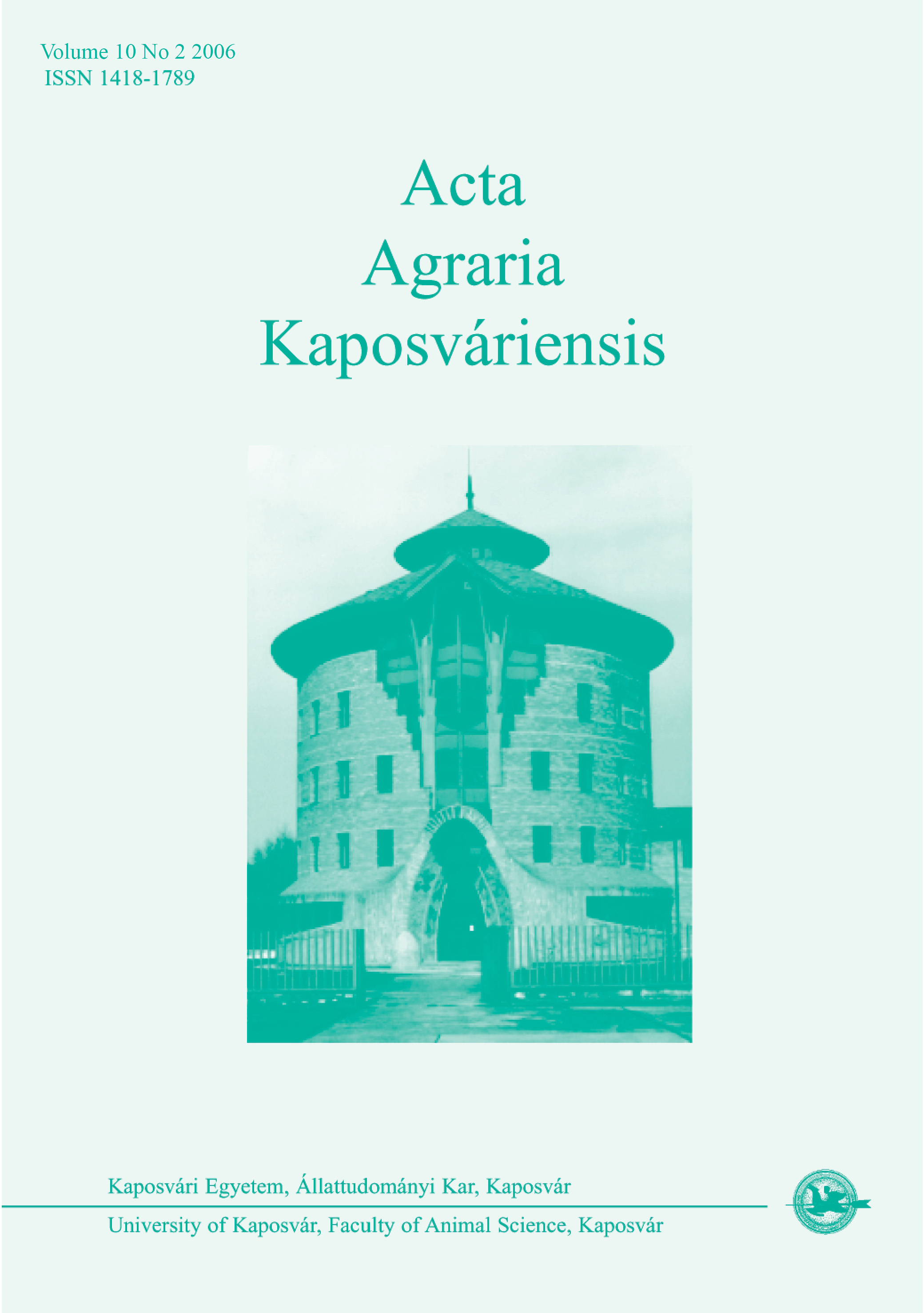Effect of different phosphorus intakes on phosphorus balance and performance of layers during peak production
Kulcsszavak:
dietary phosphorus, phosphorus balance, phosphorus retention, egg productionAbsztrakt
Two experiments were conducted to determine the effect of different phosphorus supplies on phosphorus balance and performance of high performance layers. Both experiments were conducted with 72 HyLine layers (18 birds/treatment; 3 birds/cage). Hens were fed diets containing 2.5; 2.0; 1.5 and 1.0 g/kg non-phytate phosphorus (NPP). The calcium content was maintained constant at 32.5 g/kg. In the balance trial, the hens were 45 weeks of age (25 week of production). At the beginning of the performance trial the birds were 45 weeks old and were fed for 12 weeks. Absolute P retention was calculated subtracting the mean P excretion in the excreta from the P intake. Relative P retention was calculated absolute P retention dividing by P intake. Decreasing dietary NPP levels reduced P excretion in the excreta. Relative P retention was not influenced by levels of NPP. Decreasing dietary NPP reduced absolute P retention and P balance. Hens fed 1.5 and 1.0 g/kg NPP showed the lowest P balance at 43 and 39 mg/d, respectively, which was still adequate for the birds. Diets had no effect on feed intake, egg weight and feed per egg mass (P ≥ 0.05). As NPP decreased from 1.5 to 1.0 g/kg, egg production and egg mass decreased (P ≤ 0.05). It was concluded that dietary P content can be reduced up to 1.5 g/kg NPP without influencing the level of production, and at the same time the environment is also alleviated.
Hivatkozások
AOAC (1999). Official Methods of Analysis. 16th ed. Association of Official Analytical Chemists, Arlington, VA.
Castillo C., Cuca, M., Pro, A., González, M., Morales, E. (2004). Biological and economic optimum level of calcium in white Leghorn laying hens. Poult. Sci., 83(6), 868–872. https://doi.org/10.1093/ps/83.6.868
Keshavarz, K. (1985). The effect of dietary levels of calcium and phosphorus on performance and retention of these nutrients by laying hens. Poult. Sci., 65(1), 114–121. https://doi.org/10.3382/ps.0650114
Kovács, R. K., Tossenberger, J., Babinszky, L. (2006). Effect of different phosphorus intakes on phosphorus balance and performance of layers. 13th International Conference. Krmiva, June 5–8.
Leeson, S., Summers, J. D., Caston, L. (1993). Response of brown-egg strain layers to dietary calcium or phosphorus. Poult. Sci., 72(8), 1510–1514. https://doi.org/10.3382/ps.0721510
NRC, Nutrient Requirements of Poultry (1994). 9th Revised Edition, National Academic Press, Washington.
SAS (2001). SAS User’s Guide. Statistics. Inst., Inc.Cary, NC.
Scheideler, S.E., Jerry, S.L. (1986). Effects of calcium and phase-feeding phosphorus on production traits and phosphorus retention in two strains of laying hens. Poult. Sci., 65(11), 2110–2119. https://doi.org/10.3382/ps.0652110
Sohail, S. S., Roland, D. A. (2002). Influence of dietary phosphorus on performance of Hy-Line W36 hens. Poult. Sci., 81(1), 75–83. https://doi.org/10.1093/ps/81.1.75
Summers, D. J. (1995). Reduced dietary phosphorus levels for layers. Poult. Sci., 74(12), 1977–1983. https://doi.org/10.3382/ps.0741977
Usayran, N., Balnave, D. (1994). Phosphorus requirements of laying hens fed on wheat-based diets. Br. Poultry Sci., 62. 1033–1037.
Letöltések
Megjelent
Folyóirat szám
Rovat
License
Copyright (c) 2006 Kovács Réka Katalin, Tossenberger János, Babinszky László

This work is licensed under a Creative Commons Attribution-NonCommercial-NoDerivatives 4.0 International License.






